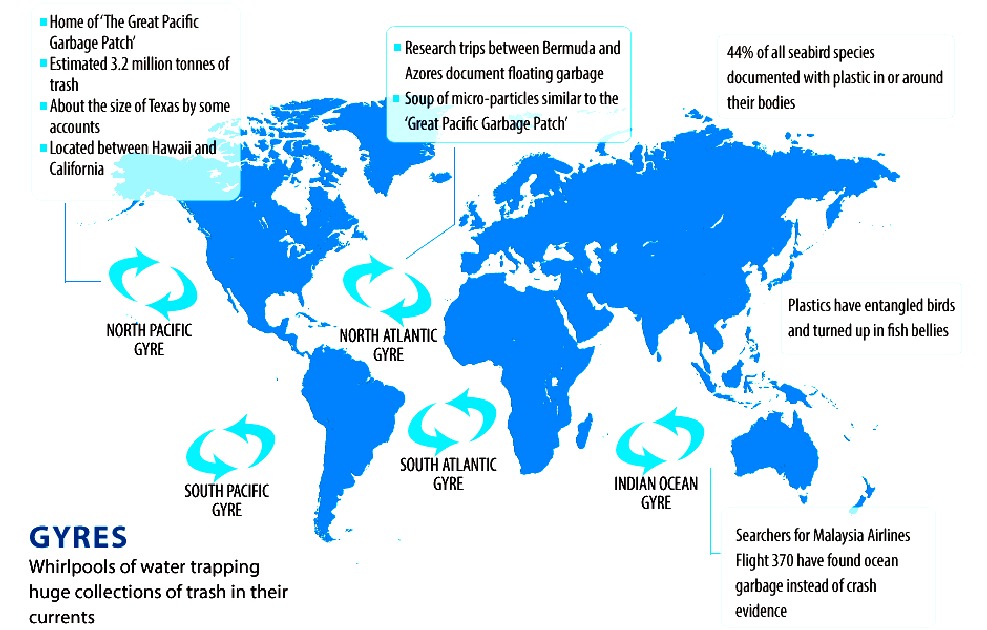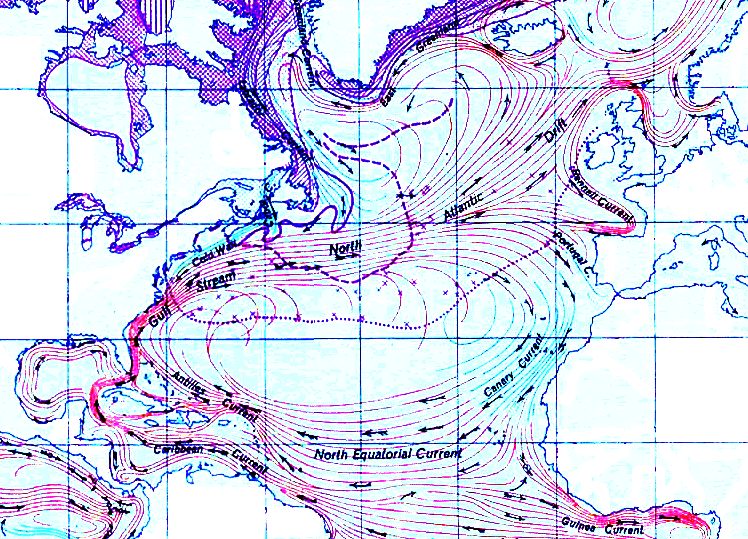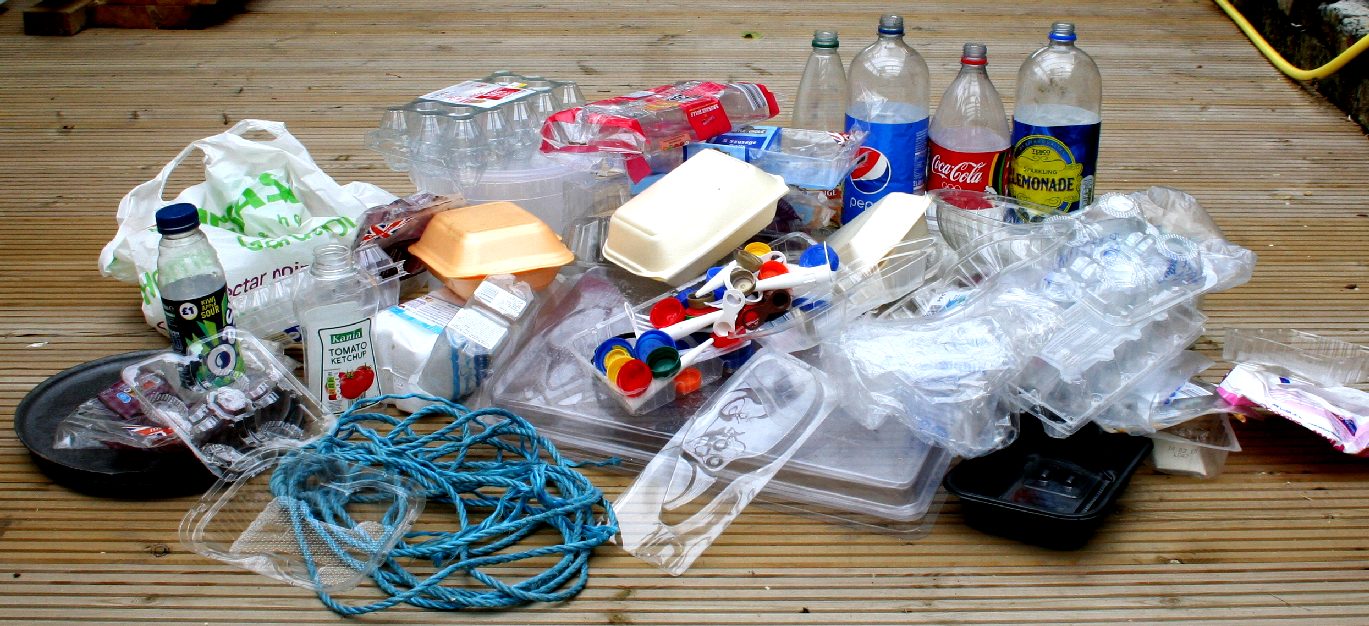|

BUILD
UP
- Plastic has accumulated in five ocean hot spots called
gyres, seen here in this world map derived from information
published by 5 Gyres.
The movement of the world’s major ocean gyres helps drive the “ocean conveyor belt.” The ocean conveyor belt circulates ocean water around the entire
planet, making this an international problem.
There
are 5 swirling ocean garbage patches called
gyres.
Garbage patches generally accumulate far from any country’s coastline, and it is nearly impossible to track the origin of marine debris. The tiny plastic particles that make up most of the patches are also very difficult and expensive to detect and remove.
1.
North Atlantic Gyre 2.
South Atlantic Gyre 3.
Indian Ocean Gyre 4.
North Pacific Gyre 5.
South Pacific Gyre
To date no nation has accepted responsibility for cleaning up the ocean’s garbage
patches to the extent that they will agree to fund ocean cleaning up operations.
Such Agreement could allow a commercial approach to venture capitalists.
It
is estimated that fleets of SeaVax vessels could recover much of the plastic
entering our oceans each year, and with more vessels operating, even begin
to clean up the gyres where plastic is more concentrated. This represents a
potential solution that the world powers are looking for.
On
land, the G20 have agreed to work to reduce single use plastic
in the hope
of slowing build up in the ocean, unfortunately this plan leaves plastic in our
oceans to alter marine ecology, kill seabirds, contaminate fish
and kill marine mammals.
The
G7
have created a fund for academics and innovation competitions looking for
ways to tackle ocean plastic waste. The Cleaner
Ocean Foundation does not qualify for such funding where these baits
assume corporate trading and profits from which to carve an R&D budget,
leaving SeaVax
and RiverVax
development out in the cold when run by a not for profit organization with charitable
objects as at present.
The
Foundation does not qualify for registration according to the UK Charity
Commission, despite acknowledgement of societal good works. This leaves donations
and crowdfunding
as our last hope unless governments are prepared to award paying contracts.
It is doubtful that could ever happen.

PROTESTS
- One way of drawing attention
to a social problem like marine litter is to peacefully demonstrate with
signs like this that say it all. By keeping the subject live in the minds of
politicians, eventually they will be forced into acting responsibly.
ABOUT
THE NAG
The North Atlantic Gyre, located in the Atlantic Ocean, is one of the five major oceanic gyres. It is a circular system of ocean currents that stretches across the North Atlantic from near the equator almost to Iceland, and from the east coast of North America to the west coasts of Europe and Africa.
The currents that compose the North Atlantic Gyre include the Gulf Stream in the west, the North Atlantic Current in the north, the Canary Current in the east, and the Atlantic North Equatorial Current in the south. This gyre is particularly important for the central role it plays in the thermohaline circulation, bringing salty water west from the Mediterranean Sea and then north to form the North Atlantic Deep Water.
The North Atlantic Gyre traps man-made marine debris in the North Atlantic Garbage Patch, similar to how the North Pacific Gyre traps debris in the Great Pacific Garbage Patch.
The North Atlantic Gyre forms the Sargasso Sea, noted for its still waters and dense seaweed accumulations.

SEASONAL
VARIATIONS
As with many oceanographic patterns, the North Atlantic Gyre experiences seasonal changes. Stramma and Siedler (1988) determined that the gyre expands and contracts with a seasonal variance; however, the magnitude of volume transport does not seem to change significantly. During the Northern Hemisphere winter season, the gyre follows a more zonal pattern; that is, it expands in the east-west direction and thins in the north-south direction. As the seasons move from winter to summer, the gyre shifts south by a few degrees latitude. This occurs concurrently with the displacement of the northeastern part of the gyre. It has been concluded that zonal deviations within the gyre remain small while north and south of the gyre they are large.
Data collected in the Sargasso Sea region in the western part of the North Atlantic Gyre has led to analytical evidence that the variability of this gyre is linked to wintertime convective mixing. According to Bates (2001), a seasonal variation of 8-10 °C in surface temperature occurs alongside a fluctuation in the mixed layer depth between the Northern Hemisphere winter and summer seasons. The depth rises from 200 meters in winter to about 10 meters in summer. Nutrients remain below the euphotic zone for most of the year, resulting in low primary production. Yet during winter convective mixing, nutrients penetrate the euphotic zone, causing a short-lived phytoplankton bloom in the spring. This then lifts the mixed-layer depth to 10 meters.
The changes in oceanic biology and vertical mixing between winter and summer in the North Atlantic Gyre seasonally alter the total amount of carbon dioxide in the seawater. Interannual trends have established that carbon dioxide concentrations within this gyre are increasing at a similar rate to that occurring in the atmosphere. This discovery concurs with that made in the North Pacific Gyre. The North Atlantic Gyre also undergoes temperature changes via atmospheric wave patterns. The North Atlantic Oscillation (NAO) is one such pattern. During its positive phase, the gyre warms. This is due to a weakening of the westerly winds, resulting in reduced wind stress and heat exchange, providing a greater period of time for the gyre water temperatures to rise.
LEAD CONTAMINATION
Collections of aerosols, marine particles, and ocean water in the North Atlantic Gyre from 1990-1992 have led to measurements in lead isotope ratios. These measurements exceed those associated with atmospheric pollution carried from Europe by the trade winds, implying that the majority of lead contamination in the gyre in the early 1990s was primarily caused by American emissions. The surface layers of the Sargasso Sea were used to estimate the lead isotopic concentrations. 42-57% of the lead isotope concentrations result from American industrial and automotive contamination, despite the reduction in the production and use of leaded gasoline in the United States. However, lead concentrations from measurements made after 1992 show a decrease in the amount of lead contamination.

FAST
FOOD
- It's not just fast food, it
is our exploitative society that is poisoning the planet, without thought
for the consequences. We've been living at artificially low prices at the
expense of killing other life on earth.
|



